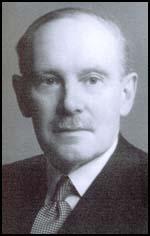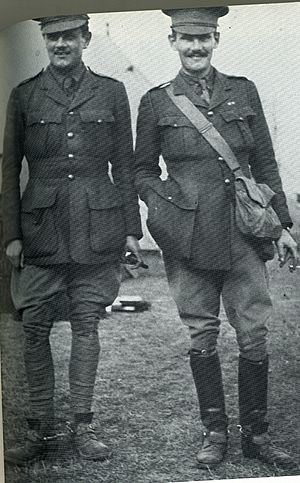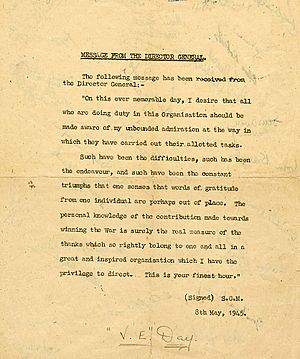Stewart Menzies facts for kids
Quick facts for kids Major GeneralSir Stewart Menzies KCB KCMG DSO MC |
|
|---|---|
 |
|
| Allegiance | United Kingdom |
| Service | Secret Intelligence Service (SIS/MI6) |
| Rank | Chief of the Secret Intelligence Service |
| Operation(s) | First World War Second World War Cold War |
|
|
|
| Birth name | Stewart Graham Menzies |
| Born | 30 January 1890 London, England |
| Died | 29 May 1968 (aged 78) London, England |
| Nationality | British |
| Parents | John Graham Menzies, Susannah West Wilson |
| Spouse |
|
| Children | Fiona (b. 1934) |
| Occupation | Intelligence officer |
Major General Sir Stewart Graham Menzies was a very important British spy chief. He led MI6, which is the UK's secret intelligence service, from 1939 to 1952. This period included the Second World War and the start of the Cold War. He played a key role in Britain's secret operations during these times.
Contents
Early Life and Education
Stewart Graham Menzies was born in London, England, in 1890. He came from a well-off family. His grandfather, Graham Menzies, was a successful whisky maker. Stewart's parents were even friends with King Edward VII.
Stewart went to Eton College, a famous school. He was very good at sports like hunting and running. He also won awards for learning languages. He was seen as a smart and well-rounded student. He finished school in 1909.
Early Military Career
Joining the Army
After Eton, Stewart Menzies joined the Grenadier Guards as a Second Lieutenant. After a year, he moved to the Second Life Guards. By 1913, he was promoted to Lieutenant and became an Adjutant, which is an officer who helps with administrative tasks.
Fighting in World War I
During the First World War, Menzies served in Belgium. He was hurt in October 1914. He showed great bravery in the First Battle of Ypres in November 1914. He was promoted to captain and received the DSO award from King George V himself.
His regiment faced heavy losses in 1915. Menzies was seriously injured in a gas attack that year. Because of his injuries, he was honorably discharged from active fighting.
Moving to Intelligence
After leaving combat, Menzies joined the counterintelligence section. This group worked to stop enemy spies and gather secret information. He worked for Field Marshal Douglas Haig, a top British commander. Menzies was promoted to major before the war ended.
Joining MI6
After the First World War, Menzies joined MI6, also known as the Secret Intelligence Service (SIS). He was part of the British group at the 1919 Versailles Peace Conference, which set the terms for peace after the war.
He quickly rose through the ranks in MI6. By 1929, he became the deputy director. He was promoted to full colonel soon after.
Chief of MI6
In 1939, Stewart Menzies became the Chief of MI6. This was just as the Second World War was beginning. He made MI6 much bigger during the war. He also oversaw the important codebreaking work happening at Bletchley Park.
Role in the Second World War
Menzies insisted that MI6 control all codebreaking efforts. This gave him a lot of power. He used this power wisely. MI6 became very important because it shared secret information called Ultra. This information came from breaking Nazi codes, especially those from their Enigma machines.
Ultra gave Menzies and his team amazing insights into Adolf Hitler's plans. This was a huge secret, kept hidden until 1974. The Nazis never knew their codes were being read.
Menzies gave Prime Minister Winston Churchill daily updates from the Ultra decrypts. They worked together to make sure Bletchley Park had enough money and talented people. By 1945, nearly 10,000 people worked there.
Bletchley's work was crucial in fighting Nazi submarine warfare. These submarines were sinking many ships bringing supplies across the Atlantic. Britain relied on these supplies to survive. Access to Ultra was also vital for the D-Day invasion in June 1944 and the battles that followed.
Menzies was promoted to major-general in January 1944. He also supported efforts to contact anti-Nazi groups in Germany. Churchill was always kept informed. Menzies worked with other secret organizations like the Special Operations Executive (SOE) and the Office of Strategic Services (OSS).
After the Second World War
After the war, Menzies reorganized MI6 for the Cold War. He brought many parts of the SOE into MI6. He faced challenges, including a scandal when an MI6 officer, Kim Philby, was found to be a Soviet spy.
Menzies retired in 1952 after 43 years of service. He was 62 years old. His leadership played a major part in winning the Second World War. He met with Winston Churchill almost 1,500 times during the war, showing how important his role was.
Fictional Appearances
Stewart Menzies has been shown in movies:
- In the 2014 film The Imitation Game, he is played by Mark Strong.
- In the 2021 film Munich – The Edge of War, he is played by Richard Dillane.
Honours and Awards
| Knight Commander of The Most Honourable Order of the Bath (KCB) | 7 June 1951 | ||
| Knight Commander of the Order of St Michael and St George (KCMG) | 1 January 1943 | ||
| Distinguished Service Order (DSO) | 1 December 1914 | For bravery during an attack in November 1914. | |
| Military Cross (MC) | 3 July 1915 | For showing great skill and calmness in battle near Ypres in May 1915. | |
| 1914 Star | |||
| British War Medal | |||
| Victory Medal | |||
| 1939–1945 Star | |||
| War Medal 1939–1945 | |||
| King George V Coronation Medal | 1911 | ||
| King George V Silver Jubilee Medal | 1935 | ||
| King George VI Coronation Medal | 1937 | ||
| Queen Elizabeth II Coronation Medal | 1953 | ||
| Knight of the Order of the Crown (Belgium) | 14 February 1917 | ||
| Knight of the Order of the Legion of Honour (France) | 2 June 1917 | ||
| War Cross (Belgium) | 11 March 1918 | ||
| Commander's Cross of the Order of the Rebirth of Poland (Poland) | 8 October 1943 | ||
| War Cross 1940 with Palm (Belgium) | 16 January 1947 | ||
| Grand Officer of the Order of Leopold with Palm (Belgium) | 16 January 1947 | ||
| Grand Officer of the Order of Orange Nassau (Netherlands) | 14 May 1948 | ||
| Commander with Star of the Order of Saint Olav (Norway) | 19 November 1948 | ||
| Commander of the Legion of Merit (United States) | 28 January 1949 | ||
| Order of the Yugoslav Crown (Yugoslavia) |



